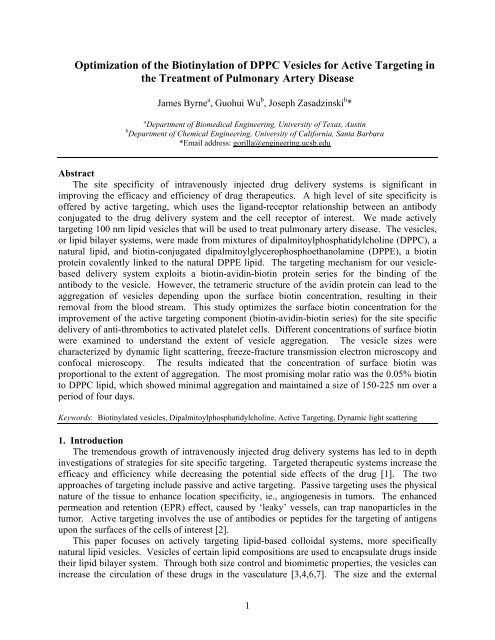The Secret Society: Descendants of Crypto-Jews in the San Antonio ...
The Secret Society: Descendants of Crypto-Jews in the San Antonio ...
The Secret Society: Descendants of Crypto-Jews in the San Antonio ...
You also want an ePaper? Increase the reach of your titles
YUMPU automatically turns print PDFs into web optimized ePapers that Google loves.
Optimization <strong>of</strong> <strong>the</strong> Biot<strong>in</strong>ylation <strong>of</strong> DPPC Vesicles for Active Target<strong>in</strong>g <strong>in</strong><br />
<strong>the</strong> Treatment <strong>of</strong> Pulmonary Artery Disease<br />
James Byrne a , Guohui Wu b , Joseph Zasadz<strong>in</strong>ski b *<br />
a Department <strong>of</strong> Biomedical Eng<strong>in</strong>eer<strong>in</strong>g, University <strong>of</strong> Texas, Aust<strong>in</strong><br />
b Department <strong>of</strong> Chemical Eng<strong>in</strong>eer<strong>in</strong>g, University <strong>of</strong> California, <strong>San</strong>ta Barbara<br />
*Email address: gorilla@eng<strong>in</strong>eer<strong>in</strong>g.ucsb.edu<br />
Abstract<br />
<strong>The</strong> site specificity <strong>of</strong> <strong>in</strong>travenously <strong>in</strong>jected drug delivery systems is significant <strong>in</strong><br />
improv<strong>in</strong>g <strong>the</strong> efficacy and efficiency <strong>of</strong> drug <strong>the</strong>rapeutics. A high level <strong>of</strong> site specificity is<br />
<strong>of</strong>fered by active target<strong>in</strong>g, which uses <strong>the</strong> ligand-receptor relationship between an antibody<br />
conjugated to <strong>the</strong> drug delivery system and <strong>the</strong> cell receptor <strong>of</strong> <strong>in</strong>terest. We made actively<br />
target<strong>in</strong>g 100 nm lipid vesicles that will be used to treat pulmonary artery disease. <strong>The</strong> vesicles,<br />
or lipid bilayer systems, were made from mixtures <strong>of</strong> dipalmitoylphosphatidylchol<strong>in</strong>e (DPPC), a<br />
natural lipid, and biot<strong>in</strong>-conjugated dipalmitoylglycerophosphoethanolam<strong>in</strong>e (DPPE), a biot<strong>in</strong><br />
prote<strong>in</strong> covalently l<strong>in</strong>ked to <strong>the</strong> natural DPPE lipid. <strong>The</strong> target<strong>in</strong>g mechanism for our vesiclebased<br />
delivery system exploits a biot<strong>in</strong>-avid<strong>in</strong>-biot<strong>in</strong> prote<strong>in</strong> series for <strong>the</strong> b<strong>in</strong>d<strong>in</strong>g <strong>of</strong> <strong>the</strong><br />
antibody to <strong>the</strong> vesicle. However, <strong>the</strong> tetrameric structure <strong>of</strong> <strong>the</strong> avid<strong>in</strong> prote<strong>in</strong> can lead to <strong>the</strong><br />
aggregation <strong>of</strong> vesicles depend<strong>in</strong>g upon <strong>the</strong> surface biot<strong>in</strong> concentration, result<strong>in</strong>g <strong>in</strong> <strong>the</strong>ir<br />
removal from <strong>the</strong> blood stream. This study optimizes <strong>the</strong> surface biot<strong>in</strong> concentration for <strong>the</strong><br />
improvement <strong>of</strong> <strong>the</strong> active target<strong>in</strong>g component (biot<strong>in</strong>-avid<strong>in</strong>-biot<strong>in</strong> series) for <strong>the</strong> site specific<br />
delivery <strong>of</strong> anti-thrombotics to activated platelet cells. Different concentrations <strong>of</strong> surface biot<strong>in</strong><br />
were exam<strong>in</strong>ed to understand <strong>the</strong> extent <strong>of</strong> vesicle aggregation. <strong>The</strong> vesicle sizes were<br />
characterized by dynamic light scatter<strong>in</strong>g, freeze-fracture transmission electron microscopy and<br />
confocal microscopy. <strong>The</strong> results <strong>in</strong>dicated that <strong>the</strong> concentration <strong>of</strong> surface biot<strong>in</strong> was<br />
proportional to <strong>the</strong> extent <strong>of</strong> aggregation. <strong>The</strong> most promis<strong>in</strong>g molar ratio was <strong>the</strong> 0.05% biot<strong>in</strong><br />
to DPPC lipid, which showed m<strong>in</strong>imal aggregation and ma<strong>in</strong>ta<strong>in</strong>ed a size <strong>of</strong> 150-225 nm over a<br />
period <strong>of</strong> four days.<br />
Keywords: Biot<strong>in</strong>ylated vesicles, Dipalmitoylphosphatidylchol<strong>in</strong>e, Active Target<strong>in</strong>g, Dynamic light scatter<strong>in</strong>g<br />
1. Introduction<br />
<strong>The</strong> tremendous growth <strong>of</strong> <strong>in</strong>travenously <strong>in</strong>jected drug delivery systems has led to <strong>in</strong> depth<br />
<strong>in</strong>vestigations <strong>of</strong> strategies for site specific target<strong>in</strong>g. Targeted <strong>the</strong>rapeutic systems <strong>in</strong>crease <strong>the</strong><br />
efficacy and efficiency while decreas<strong>in</strong>g <strong>the</strong> potential side effects <strong>of</strong> <strong>the</strong> drug [1]. <strong>The</strong> two<br />
approaches <strong>of</strong> target<strong>in</strong>g <strong>in</strong>clude passive and active target<strong>in</strong>g. Passive target<strong>in</strong>g uses <strong>the</strong> physical<br />
nature <strong>of</strong> <strong>the</strong> tissue to enhance location specificity, ie., angiogenesis <strong>in</strong> tumors. <strong>The</strong> enhanced<br />
permeation and retention (EPR) effect, caused by ‘leaky’ vessels, can trap nanoparticles <strong>in</strong> <strong>the</strong><br />
tumor. Active target<strong>in</strong>g <strong>in</strong>volves <strong>the</strong> use <strong>of</strong> antibodies or peptides for <strong>the</strong> target<strong>in</strong>g <strong>of</strong> antigens<br />
upon <strong>the</strong> surfaces <strong>of</strong> <strong>the</strong> cells <strong>of</strong> <strong>in</strong>terest [2].<br />
This paper focuses on actively target<strong>in</strong>g lipid-based colloidal systems, more specifically<br />
natural lipid vesicles. Vesicles <strong>of</strong> certa<strong>in</strong> lipid compositions are used to encapsulate drugs <strong>in</strong>side<br />
<strong>the</strong>ir lipid bilayer system. Through both size control and biomimetic properties, <strong>the</strong> vesicles can<br />
<strong>in</strong>crease <strong>the</strong> circulation <strong>of</strong> <strong>the</strong>se drugs <strong>in</strong> <strong>the</strong> vasculature [3,4,6,7]. <strong>The</strong> size and <strong>the</strong> external<br />
1
















